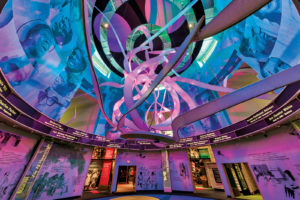
Visitors to the new Mississippi Civil Rights Museum in Jackson, Miss., are bound to be moved by the multiplicity of impressions, sounds, lights and graphic images that could only be presented with the aid of fabric. “This Little Light of Mine,” the name of the main exhibition at the Jackson museum, aims to immerse visitors in the trajectory of the U.S. civil rights story and the implications of this defining American experience.
Echoing the iconic civil rights song, the exhibit “This Little Light of Mine” spotlights the people, events and venues associated with the movement, both figuratively and literally. With more than 6,000 individual LED lights implanted in the exhibit’s multiple sections—all digitally controlled by visitor-responsive sensors in sync with audio narrations and historical film/video clips—guests to the museum are surrounded with information that brings history to life beyond what could be accomplished today by any other means.
Until VR (virtual reality) and AR (augmented reality) become so completely believable that they replace reality itself, nothing can compare to actual physical movement and engagement with spaces in the public realm. In truth, we are seeing a reaction on the part of the public seeking more “real” versus “virtual” experiences as shopping transforms itself to event-driven opportunities, and people tend to favor craft breweries and handmade products over mass-marketed restaurants or merchandise. Fabric contributes to the authentic experience of real public engagement like no other material.
Measuring success
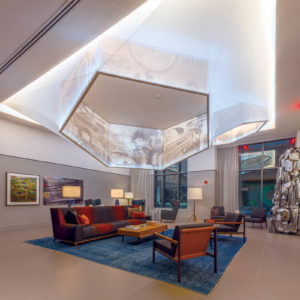
For Cindy Thompson, founder and CEO of Transformit in Gorham, Maine, a successful project involves regular and constant communication between all the project team members. Transformit’s “This Little Light of Mine” team included lighting designers Consolidated Electrical Distributors (CED), exhibit designers Hilferty & Associates, media designers Monadnock Media and Transformit’s own fabricators and installers.
“The project took about three months to install overall,” says Thompson. “It’s all about telling a story and listening to each other in the collaborative team to make sure that what’s put in place represents the right story in the right way. We’re not just ‘vendors’ to the museums and hospitality companies that we work with. We’re collaborators, and in the end we feel good about the work. The way I determine success is if it looks beautiful, works great visually in its space, and the client loves it, financial success follows.”
For Bruce Dickinson, vice president of development at Rainier Industries Ltd., Tukwila, Wash., the company’s work on the London Olympic Stadium for the 2012 Summer Olympic Games was a resounding success. “There was a lot of fabric used to wrap the exterior of the stadium,” says Dickinson. “It featured sustainable fabric in a color wheel of 336 unique color printed fabric panels. Each panel was half white and half colored. It was a challenge to make the sustainable requirements put forth by the Olympic Committee, but we were part of a tremendous team that included Dow Chemical, Cooley, FabriTec Structures and Rainier Industries.”
The 2012 London Olympic Committee was driven by the mandate to make the Olympic Games as green as possible. It strictly forbade the use of any PVC in any sports event structures or ancillary structures throughout the Games, so the fabric that shaded the Olympic Stadium structure was designed to be completely recycled.
Eventscape Inc., Toronto, Ont., Canada, is well-known for being able to incorporate multiple materials into each project. Success for the architectural fabrication company relies on internal skills. “Our extensive in-house capabilities allow us to tackle each project in numerous materials while educating our clients on the pros and cons of each,” says Elaine Allen-Milne, marketing and communications manager. “The advantages with textiles typically are their lightweight nature and the ability to produce large surfaces with minimal seams.”
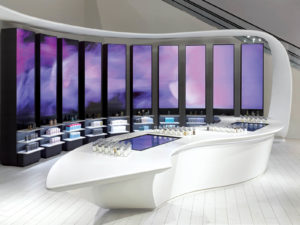
“Our work on the Missouri History Museum backlit light boxes was a very successful project,” says Jim Knoche, exhibit solutions representative of Lawrence Fabric & Metal Structures Inc., St. Louis, Mo. “I would say that client approval and profitability of the project are key factors in determining the success or lack of success of a project.”
“Fabric can do almost anything, if and when you understand its behavior and how to work within its constraints,” says Heidi Katherine, senior vice president, global design and development, for Moss Inc., Elk Grove Village, Ill. “We do that all day and therefore can provide valuable expertise to help our customers’ visions shine. Our most successful projects tend to occur when we are brought in as a consultative partner early in the process. Success at Moss is defined by three factors: the quality of the visual, the growth of our partnerships with our customers, and a deeper understanding of the market challenges we should develop against.
If we do that, it’s a win-win.”
Fabric as the top choice
All of the companies interviewed for this article agreed that much has changed in recent years with regard to technologies and the nature of the business of graphic display. But the choice of fabric as a basis for creating dynamic, sculptural displays hasn’t changed, nor has the design process. “There is still much the same, as with any creative problem-solving,” says Thompson. “That’s still important, and our process of creating unique designs remains steady and the same as always. What’s changed a lot is the technical side.”
Yet fabric continues to play a big part in Transformit’s work. “Fabric is an ideal vehicle for light and graphics, and it offers designers a wonderful range of flexibility,” says Thompson. “Overall, fabric is easier to maintain than a hard surface. We design our structures so the fabric can be removed for cleaning. And we preserve the patterns we used to create the piece, so repairs and replacements
can be readily made in the future.”
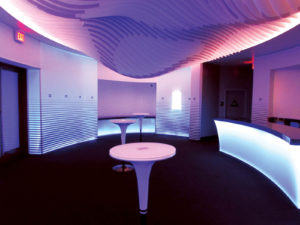
Not all clients understand the advantages of fabric for display, but once those differences are pointed out, many clients go along with the choice. “Typically with Rainier, clients have been artists, architects or designers,” says Dickinson. “Sometimes we get a request because of our expertise with fabric. Often clients have a vision of what they want to do, but don’t know how to do it. We will have a conversation with them before making recommendations. For example, in a new Salt Lake City airport project we proposed the use of fabric and a framing system that is highly sculptural. It’s to be a 400- to 500-foot long installation inside the new terminal that suggests the canyons of Utah. Working closely with the clients, we will explore what is best for a project in parallel with the client team.”
“Typically the client requests fabric,” says Knoche at Lawrence. “Sometimes we suggest a change from another substrate to fabric to save cost and ease of changeability. When the fabric is backlit, it has a softer feel than vinyl and it also allows for quality graphics.” Although Knoche acknowledges the main advantage of dye-sublimation printed fabric is that it’s washable, he believes that for routine maintenance it is more about the attachment method (e.g., silicone edge graphics (SEG), Velcro®, screws, staples), and designs are made according to the project’s best long-term benefits.
“Fabric has the ability to create complex shapes that install very quickly,” says Katherine. “Traditional fabrication would require seam patching, sanding, drying and painting after installation. At Moss, fabric allows for a less messy, controlled installation. Fabric provides scale without the addition of weight.
We use aluminum frames, which can be self-supported or suspended using less structural support than a wooden or steel fabricated structure.”
New technology and the future
As fabricators continue to incorporate new technologies, absorbing these techniques and capabilities within their skill set, there are likely to be more dynamic and engaging displays throughout the world as well as greater challenges to producing and marketing those displays.
“The future of fabric in exhibit and artistic mediums will be guided by new fabrics and the integration with technology,” says Thompson. “Yet ultimately, the success of fabric in structures depends on how well fabric artists can take their designs to market.” Eventscape’s Allen-Milne echoes Thompson’s optimism: “As new technologies and materials are developed, innovative fabrication firms such as Eventscape will be poised to incorporate them into future projects of all types.”
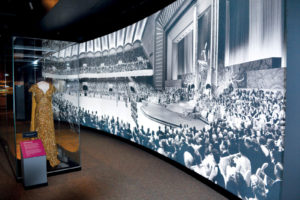
For Dickinson at Rainier Industries, new technology helped spawn a subsidiary. “We have a new 3-D tube bending machine that can bend aluminum tubing in free-form ways,” says Dickinson. “This machine is driving new growth for us into new markets. This gives us a framework, if you will, to create elaborate sculptural elements. We’ve created a separate business with its own website, Rainier Clouds, for sculptural lighting and acoustical control. So new technology opens up new areas for production. When we are thrown into challenges by client requests, it pushes us to new innovations.”
“The conceptual possibilities are endless right now,” says Moss’s Katherine. “The challenge for customers is finding the right team that understands all facets of the project from design to engineering, content, technology and installation. We expect the next three years to produce installations that create an intense shifting of the definition of physical-digital experiences. Designers are balancing how much high-tech or low-tech installation is exciting to the visitor and what is the right comfortable mix. No one wants to produce an experience that is so digital that it feels like you are looking at your email or a television and [that] produces screen fatigue. But the ability to have user-generated interactive content and quickly changing visuals is incredibly powerful for messaging and memorable interactions.”
Bruce N. Wright, AIA, is an architect, teacher, consultant to architects and designers and a frequent contributor to Specialty Fabrics Review, Fabric Architecture and Advanced Textiles Source.
 TEXTILES.ORG
TEXTILES.ORG


